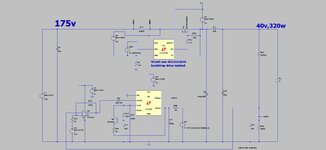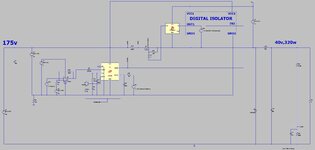cupoftea
Advanced Member level 5
Hi,
The attached shows a Hi side drive level shifter. (LTspice and jpeg scm) Ignoring its voltage rating, do you see problems with this set-up?
In the actual circuit , we would use a 2ED2182S06 Bootstrap drive chip instead of LTC4440.
The problem here seems to be that the "TS" pin of LTC4440 has to go >100V below the "GND" pin. Would you agree? This also would be a problem with 2ED2182S06?
LTC4440
2ED2182S06
The attached shows a Hi side drive level shifter. (LTspice and jpeg scm) Ignoring its voltage rating, do you see problems with this set-up?
In the actual circuit , we would use a 2ED2182S06 Bootstrap drive chip instead of LTC4440.
The problem here seems to be that the "TS" pin of LTC4440 has to go >100V below the "GND" pin. Would you agree? This also would be a problem with 2ED2182S06?
LTC4440
2ED2182S06

